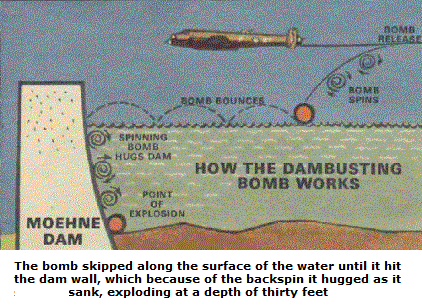|
 Barnes
Wallis's upkeep weapon commonly referred to as the bouncing
bomb, was in fact a depth charge weighing 9250 lbs including
6600 lbs of Torpex explosive. Originally 61 inches in
length it had to be shortened to 59 7/8 inches to fit within the
bomb release mechanism. Barnes
Wallis's upkeep weapon commonly referred to as the bouncing
bomb, was in fact a depth charge weighing 9250 lbs including
6600 lbs of Torpex explosive. Originally 61 inches in
length it had to be shortened to 59 7/8 inches to fit within the
bomb release mechanism.
The diameter of the upkeep weapon
was 50 inches and the casing was 3/8 inch thick. The
weapon was detonated at 30 feet below the surface of the water
by three Mk XIV hydrostatic pistols each containing a primer
charge of Tetryl. The weapon was also fitted with a
self-destructive pistol set to detonate ninety seconds after
release.
Initial tests to determine how much explosive would be required
to breach the Mohne Dam was done udder the supervision of Dr AR
Collins at the Road Research Laboratory. Initially
(November 1940 to January 1941) tests were conducted using a
1/50 scale model of the Möhne Dam at the Building Research
Station (BRS), near Watford. Small charges were exploded 0.3 to
0.9 metres from the dam. Although cracked, the dam held.
Further tests were conducted at RRL Harmondsworth, near
Heathrow. It was concluded that a 6,800 kg charge detonated 30
metres from a full-scale dam would cause severe damage but not
complete failure. Early in 1942, a test was conducted with
a charge placed in contact with a model dam (rather than at a
distance from it). This breached the dam. This was
followed on 24 July 1942 by a successful test using a 125 kg
charge in contact with the disused Nant-y-Gro
dam. In August 1942, Collins reported that a full-size
dam could be breached using a 3,400 kg charge exploded in
contact with the dam and 30 feet below the water level.
|
|
 The
bomb was given a spin in the opposite direction to the flight of
the dropping aircraft in order to flatten its trajectory.
This was important since to make an object skip across the water
it needs to hit the surface of the water
an angle of 7 degrees or less. Flattening the trajectory
meant that the bomb could be dropped from a greater height than
would otherwise be the case. The backspin also helped the
bomb to hug the dam wall as it sank so that it exploded in
direct contact with the dam wall. The
bomb was given a spin in the opposite direction to the flight of
the dropping aircraft in order to flatten its trajectory.
This was important since to make an object skip across the water
it needs to hit the surface of the water
an angle of 7 degrees or less. Flattening the trajectory
meant that the bomb could be dropped from a greater height than
would otherwise be the case. The backspin also helped the
bomb to hug the dam wall as it sank so that it exploded in
direct contact with the dam wall.
The final dropping height was perilously low. To use
Gibson's own words "You would only need to hiccup to end up in
the drink". Moreover if the bomb was dropped at altitudes
of less than 60 feet spray generated by the first bounce could
hit the tail of the aircraft causing damage, which actually
happened Les
Munro and
Henry
Maudslay, while dropping inert practice bombs as the film of
a test drop clearly shows,.
An aircraft was destroyed and the crew killed during trials in
the United States, which led to the Americans abandoning their
trial with Upkeep altogether.
On Operation Chastise - the Dams Raid - the bombs on all of the
dams but the Sorpe, were to be dropped from 60 feet at a speed
of 210 to 220 mph at a distance of 600 yards from the dam, which
gave the bomb a chance to bounce three times before crawling
down the wall of the dam and exploding.
|

 At
the Sorpe Dam, which was not a masonry dam, the aircraft flew
along the face of the dam and dropped the bomb without backspin
so that it hit the earthwork bank rolled down and sank
immediately in front of the dam. The bomb itself was not
entirely suited for this type of dam and given only two of the
aircraft tasked with attacking the Sorpe Dam actually reached
their target it is not surprising that this dam was not
breached.
At
the Sorpe Dam, which was not a masonry dam, the aircraft flew
along the face of the dam and dropped the bomb without backspin
so that it hit the earthwork bank rolled down and sank
immediately in front of the dam. The bomb itself was not
entirely suited for this type of dam and given only two of the
aircraft tasked with attacking the Sorpe Dam actually reached
their target it is not surprising that this dam was not
breached.